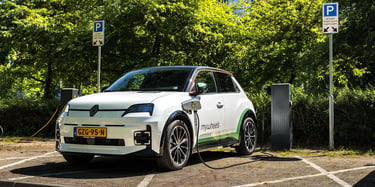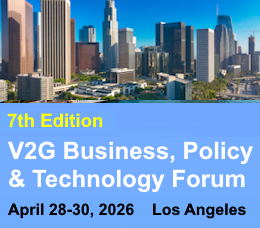Plan to attend: 7th V2G Business, Policy & Technology Forum: Spring, April 28-30, 2026 in Los Angeles. Click here for details
Utrecht Becomes Europe’s First City with a Vehicle‑to‑Grid Car‑Sharing Service
World première in bidirectional AC charging for sustainable energy storage in shared cars. Renault Group supplies 500 electric models featuring Mobilize V2G technology.
6/5/2025


Renault Group, MyWheels and We Drive Solar, together with the Municipality of Utrecht, recently announced the
go-live of Europe’s first large‑scale Vehicle‑to‑Grid car‑sharing service: Utrecht energized. The initiative supports a more sustainable, efficient energy system in a city where 35 % of rooftops are already fitted with solar panels.
Thanks to V2G technology, electric vehicles can store energy and feed it back to the local grid during peak periods, so renewable power remains available around the clock. By combining a shared‑mobility service with advanced technology, the project keeps the local grid in balance while accelerating the transition to sustainable urban transport.
The launch of this large‑scale car‑sharing service, using V2G technology was announced in November 2024 and is now live. The initiative promotes large‑scale availability of electric shared cars while helping to balance the city’s electricity network through the pioneering bidirectional charging technology. The Netherlands is a global leader in solar and wind-based energy deployment, and Utrecht ranks among Europe’s most progressive renewable‑energy cities, with 35 % of roofs equipped with solar panels.
The use of renewables presents challenges for the grid due to their massive deployment, causing high peaks in energy supply. To manage the grid with a high proportion of renewables requires a system that quickly adapts to the changes in energy generation and consumption. This is where V2G can address these challenges.
The roll‑out is now live with 50 Renault 5 E‑Tech electric cars. Available via a car‑sharing service managed by MyWheels, the vehicles use V2G bidirectional charging technology developed by Mobilize, Renault Group’s brand dedicated to new mobilities. It is the first time this innovative technology has been made available for public infrastructure, provided by We Drive Solar. The 500 bidirectional cars can deliver 10% of the flexibility required in the Utrecht region to balance solar‑ and wind‑generated electricity at peak times.
A partnership with impact
Renault’s shared cars, equipped with Mobilize’s V2G technology, are designed to allow users to charge with clean electricity and feed power back to the grid when demand is high. We Drive Solar provides advanced charging solutions: bidirectional public AC chargers and aggregation technology that support Mobilize’s V2G toolkit. The 500 Renault E‑Tech electric models are operated by MyWheels, the Netherlands’ biggest car‑sharing company.
Renault notes that the collaboration shows how public–private initiatives can deliver sustainable, efficient mobility solutions. It demonstrates that a thriving V2G ecosystem can only be achieved through the seamless collaboration of multiple players, from vehicle manufacturers and charging infrastructure providers to energy companies and local authorities. By joining forces with We Drive Solar, MyWheels, and the Municipality of Utrecht, Renault Group aims to turn V2G from a promising concept into a tangible reality.
Moving forward
To continue to deploy V2G services, a supportive regulatory framework that addresses barriers such as unfavorable tax policies, grid fee structures, and complex certification processes will be essential to fully unlock the potential of V2G and enable its widespread adoption.
Renault Group has urged policymakers and industry stakeholders to accelerate V2G deployment across Europe. Successfully implementing V2G at scale requires a harmonized approach across the entire energy ecosystem, bringing together vehicles, charging infrastructure, energy providers, and grid operators. Renault Group points out that the company is already demonstrating this in France, where customers are successfully using V2G with models like the R5, Alpine A290, R4, New Megane, and New Scenic.
While the technology is market-ready and offers significant benefits – including grid flexibility, reduced energy costs for EV owners, and a lower total cost of ownership – unlocking this potential requires overcoming current regulatory and technical barriers.
Clear and consistent regulations are needed across Europe, encompassing fiscal incentives, grid fee revisions, streamlined certification processes, and support for smart meter deployment. These measures are crucial to unlocking the potential of V2G and making it a cornerstone of a faster and more sustainable energy transition. Ultimately, this will contribute to turning every EV into a grid asset and powering a faster, smarter shift to a sustainable energy ecosystem.
"To unlock the full potential of V2G, we need to break down existing barriers – from adapting fiscal rules and grid fees to promoting interoperability and simplifying certification processes," says Jérôme Faton, Mobilize Energy director. "With the right alignment, V2G can become a cornerstone of tomorrow’s grid."
Source: Renault Group
V2G insight
Daily insights and news on the global
vehicle-to-grid market.
Contact us:
Subscribe to regular news and V2G Forum updates
info@v2gforum.com
Published by:
Smart Grid Observer
smartgridobserver.com
+1-815-310-3343
© 2025 All rights reserved.

